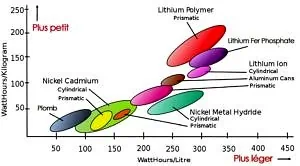
Subscribe to Newsletter
We will send you news from PowerTech Systems on a regular basis.
Maximum one email per month
Please fill-in right form with your contact details and click "Register"
[sibwp_form id=1]
It is typically considered wise to use just 30% – 50% of the rated capacity of typical lead acid “Deep Cycle” batteries. This means that a 600 amp hour battery bank in practice only provides, at best, 300 amp hours of real capacity.
If you even occasionally drain the batteries more than this their life will be drastically cut short.
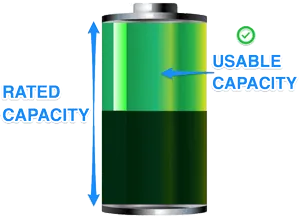
Even if never drain your battery too much, the best lead-acid batteries last only 500 to 1000 cycles. If you are frequently tapping into your battery bank, your batteries may need replacement after less than 2 years use.
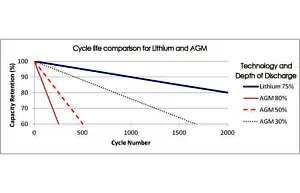
The final 20% of lead acid battery capacity can not be “fast” charged. The first 80% can be “Bulk Charged” by a smart three-stage charger quickly (particularly AGM batteries can handle a high bulk charging current), but then the “Absorption” phase begins and the charging current drops off dramatically.
Just like a software development project, the final 20% of the work can end up taking 80% of the time.
This isn’t a big deal if you are charging plugged in overnight, but it is a huge issue if you have to leave your generator running for hours (which can be rather noisy and expensive to run). And if you are depending on solar and the sun sets before that final 20% has been topped off, you can easily end up with batteries that never actually get fully charged.
Not fully charging the final few percent would not be much of a problem in practice, if it wasn’t for the fact that a failure to regularly fully charge lead acid batteries prematurely ages them.
In addition to all that wasted generator time, lead acid batteries suffer another efficiency issue – they waste as much as 15% of the energy put into them via inherent charging inefficiency. So if you provide 100 amps of power, you’ve only storing 85 amp hours.
This can be especially frustrating when charging via solar, when you are trying to squeeze as much efficiency out of every amp as possible before the sun goes down or gets covered up by clouds.
The faster that you discharge a lead acid battery of any type, the less energy you can get out of it. This effect can be calculated by applying Peukert’s Law (named after German scientist W. Peukert), and in practice this means that high current loads like an air conditioner, a microwave or an induction cooktop can result in a lead acid battery bank being able to actually deliver as little as 60% of its normal capacity. This is a huge loss in capacity when you need it most…
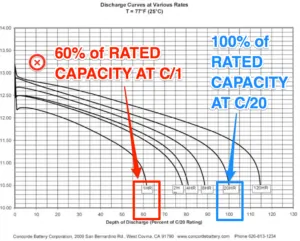
The above example shows specification of Concord AGM battery : this spec states that the battery can provide 100% of it’s rated capacity if discharged in 20 hours (C/20). If discharged in one hour (C/1), only 60% of rated capacity will be delivered by the battery. This is direct effect of Peukert losses.
At the end of the day, an AGM battery rated for 100Ah at C/20 will provide a 30Ah usable capacity when discharged in one hour as 30Ah = 100Ah x 50% DoD x 60% (Peukert losses).
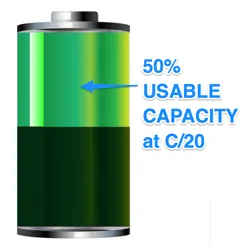 (20 hours discharge) |
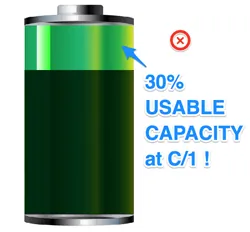 (one hour discharge) |
Flooded lead acid batteries release noxious acidic gas while they are charging, and must be contained in a sealed battery box that is vented to the outside. They also must be stored upright, to avoid battery acid spills.
AGM batteries do not have these constraints, and can be placed in unventilated areas – even inside your living space. This is one of the reasons that AGM batteries have become so popular with sailors.
Flooded lead acid batteries must be periodically topped off with distilled water, which can be a cumbersome maintenance chore if your battery bays are difficult to get to.
AGM and gel cells though are truly maintenance free. Being maintenance free comes with a downside though – a flooded cell battery that is accidentally overcharged can often be salvaged by replacing the water that boiled off. A gel or AGM battery that is overcharged is often irreversibly destroyed.
A fully charged 12-volt lead acid battery starts off around 12.8 volts, but as it is drained the voltage drops steadily. The voltage drops below 12 volts when the battery still has 35% of its total capacity remaining, but some electronics may fail to operate with less than a full 12 volt supply. This “sag” effect can also lead to lights dimming.

A typical 8D sized battery that is commonly used for large battery banks is 20.5″ x 10.5″ x 9.5″. To pick a specific 8D example, Trojan’s 8D-AGM weighs 167lbs, and provides just 230 amp-hours of total capacity – which leaves you with 115 amp hours truly usable, and only 70 for a high discharge applications!
If you are designing for extensive boon docking, you will want at least four 8D’s, or as many as eight. That is a LOT of weight to be carting around that impacts your fuel economy.
And, if you have limited space for batteries on your rig – size alone of the batteries will limit your capacity.
